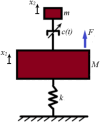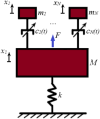Meta-frequency modulation in LQR vibration control with chirp excitation
- PMID: 40240388
- PMCID: PMC12003662
- DOI: 10.1038/s41598-025-95958-z
Meta-frequency modulation in LQR vibration control with chirp excitation
Abstract
This paper presents a comprehensive analysis of the indirect control of inertial properties of a rigid bodies system by semi-actively modifying the viscosity of tunable dampers. Linear Quadratic Regulator (LQR) optimal control logic and Hilbert-Huang Transform (HHT) analysis are employed to investigate its impact on the system response. The study utilizes a simple 2-d.o.f. architecture, referred to as the Toy Model, to demonstrate how proper selection of the damping coefficient allows for manipulation of the equivalent mass and variation of the natural frequency within a specific resonant band. Chirp excitations are applied to the Toy Model, and an iterative LQR scheme is implemented to optimally control the damping coefficient, thereby preventing resonance. Given that the adoption of the semi-active controller significantly alters the primary mass response, it is crucial to establish the cause-and-effect relationship between the control law and system response, which is achieved through the HHT. Notably, the proposed model is the first known example of a physical system that exhibits both intra- and inter-wave modulations of the instantaneous frequency of the main mass response, leading to a meta-phenomenon here defined as meta-frequency modulation. This meta-frequency modulation nonlinearly distorts the response of the optimally controlled system compared to passive optimization.
Keywords: Empirical mode decomposition; Hilbert transform; Inter-wave; Intra-wave; Linear quadratic regulator.
© 2025. The Author(s).
Conflict of interest statement
Declarations. Competing interests: The authors declare no competing interests.
Figures

























References
-
- Liu, Y., Matsuhisa, H. & Utsuno, H. Semi-Active vibration isolation system with variable stiffness and damping control. J. Sound. Vib.313(1–2), 16–28. 10.1016/j.jsv.2007.11.045 (2008).
-
- Le, T. D. & Ahn, K. K. Experimental investigation of a vibration isolation system using negative stiffness structure. Int. J. Mech. Sci.70, 99–112. 10.1016/j.ijmecsci.2013.02.009 (2013).
-
- Miah, M. S., Chatzi, E. N. & Weber, F. Semi-active control for vibration mitigation of structural systems incorporating uncertainties. Smart Mater. Struct.24, 055016. 10.1088/0964-1726/24/5/055016 (2015).
-
- Wei, X., Zhu, M. & Jia, L. A semi-active control suspension system for railway vehicles with magnetorheological fluid dampers. Veh. Syst. Dyn. Int. J. Veh. Mech. Mobil.54(7), 982–1003. 10.1080/00423114.2016.1177189 (2016).
-
- Ata, W. G. & Salem, A. M. Semi-active control of tracked vehicle suspension incorporating magnetorheological dampers. Veh. Syst. Dyn. Int. J. Veh. Mech. Mobil.55(5), 626–647. 10.1080/00423114.2016.1273531 (2017).
LinkOut - more resources
Full Text Sources

